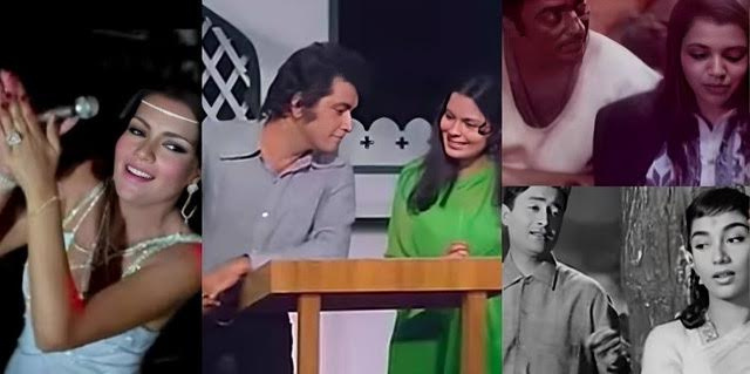The Indian film industry is witnessing a growing trend of late, the incorporation of old songs into movies. While some of the filmmakers opt to retain classic songs in their original format, another set chooses to remix the songs by adding modern beats and arrangements.
The recent usage of Tamil song ‘Kanmani Anbodu’ from Kamalhassan’s Guna in the Malayalam movie “Manjummal Boys” has indeed played an important role in revitalizing the song and introducing it to a new generation of audiences. This applies to the usage of songs like the Zeenat Aman song ‘Laila Main Laila’ from Qurbani used in Raees, Asha Bhosle and Mohammed Rafi’s ‘Abhi Na Jao Chhod Kar’ were used in Rocky Aur Rani Ki Prem Kahani. The web series Sacred Games in its Season one has used ‘Main Na Bhoolunga’ from the 1974 film Roti, Kapda Aur Makaan. The list is extensive and continues to grow.
By using old and familiar songs from past years the film makers are striving to tap into a collective cultural memory and invoking emotions and memories that resonate with viewers. While this pattern helps in the enhancement of the cinematic experience, it also can be used as a creative tool for filmmakers to augment narratives and deepen audience engagement.

“Reusing old songs has been in vogue since the remix era, in which these songs brought back the emotion of the song in a new avtaar. In movies too, the songs help to connect deeper with the audience in whose time it was originally created. However, these songs are also relatable to newer and younger audiences,” notes Chandramouli, N Chandramouli, CEO, TRA Research.

According to Jyoti Malladi, Managing Director (Research), at Ipsos India, this trend could help as a pull factor for the family viewers and older audiences to the movies.
“Nostalgia as a trend is gaining popularity across. It’s the longing for the past or rather the yearning for simpler times that evokes familiarity, warmth and fondness in the viewer. Movies have seen the use of old songs to harness the same. This could help as a pull factor for the family viewers and older audiences,” she said.
“In today’s context, with a milieu of content options available, old, familiar, repeat value, songs help cue memories of a period when things were simple. Songs in Hindi cinema isn’t just an element of moviemaking, in many ways it defines the character of the movie. Old songs in contemporary movies help bring back the old, cherished melodies and build a bridge between generations,” Malladi added.

According to Kowshik Komandur, Associate Vice-President at OnMobile Global Limited & Brand Strategist, this practice serves multiple purposes beyond evoking nostalgia, contributing significantly to audience engagement and box office success while also appealing to demographics that may have otherwise shied away from watching certain films. Moreover, it presents a lucrative opportunity for music labels in terms of licensing revenue and copyright management.
He elaborates, “Old songs are often deeply ingrained in the cultural fabric and collective memory of audiences, spanning generations. By incorporating these songs into films, filmmakers tap into nostalgia, triggering emotional connections with viewers.”
This emotional resonance, according to Komandur, can significantly enhances audience engagement, as viewers not only enjoy the familiarity of the music but also experience a heightened sense of connection to the storyline and characters.
“Moreover, these songs can serve as powerful storytelling devices, reinforcing themes, moods, and character arcs within the narrative,” he notes.
“While certain age demographics may be more inclined to gravitate towards films featuring music from their youth, the incorporation of old songs into movies can act as a pull factor for a broader spectrum of viewers,” Komandur underlined.
Business aspects
“From a business perspective, the licensing of old songs for use in films presents a lucrative revenue stream for music labels and rights holders. By granting filmmakers’ permission to use their catalog of songs, music labels can negotiate licensing fees, royalties, and other financial arrangements, generating additional income from assets that may have otherwise been underutilized,” Komandur notes.
“Old is gold, filmmakers are willing to pay a premium to recast old songs in order to create a musical hook with old popular songs,” Malladi said.
“Furthermore, the exposure gained through film placement can lead to increased sales and streaming activity for these songs, revitalizing interest in classic tracks and bolstering their commercial viability in the digital age. Additionally, the inclusion of old songs in popular films can enhance the cultural relevance and longevity of these musical works, further enriching their value as intellectual property assets for music labels,” he notes.
In Komandur’s opinion, beyond financial considerations, the licensing of old songs for use in movies also facilitates effective copyright management and preservation efforts.
“By establishing clear licensing agreements and royalty structures, music labels can protect their intellectual property rights and ensure proper compensation for the use of their songs. Moreover, the inclusion of old songs in films helps to preserve and promote these musical works for future generations, ensuring their continued relevance and cultural significance. Through strategic partnerships with filmmakers and production studios, music labels can leverage the exposure provided by movies to introduce classic songs to new audiences and uphold their legacy in the ever-evolving landscape of popular culture,” Komandur surmised.

















